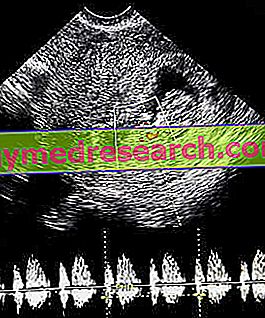Functions
During pregnancy, the amniotic fluid envelops the product of conception, absorbing and damping the insults of the outside world, such as bumps and various pressures. Similarly, the amniotic fluid protects the surrounding tissues of the mother from the movements of the fetus, which are facilitated by its very presence. This fluid also acts as a thermal insulator and allows the optimal development of the various body structures of the fetus.
Amniotic cavity

In the earliest stages of development, the amniotic fluid is secreted by the same cells as the amnios; subsequently, throughout the first trimester of pregnancy, its accumulation is linked to the transudation of maternal - fetal plasma that circulates in the interstitial spaces of the membranes.
Synthesis and Composition
In the second trimester and up to the twentieth week of pregnancy, the amniotic fluid presents a composition and an osmolarity superimposable to those of the blood of the mother and the fetus, whose skin is permeable to water, electrolytes, urea and creatinine .
After the twentieth week the amniotic fluid begins to be integrated and progressively replaced by the urine of the fetus, thanks to the maturation of its renal excretion. From here until the end of gestation, the fetus will participate not only in the production of the amniotic fluid, but also in its replacement; in fact, around the fifth month, he begins to swallow a part of the liquid, absorbing it through the intestine (to the delight of urine therapy supporters ...).
The product of conception is defined:
- zygote: from fertilization to the end of the second week;
- embryo: from the third week to the end of the third month;
- fetus: from the fourth month to the birth.
During pregnancy, the fetus produces large amounts of sebum, necessary to form the so-called caseous paint, a lipid layer that protects its skin from maceration induced by the amniotic fluid.
Once in the blood stream, through the umbilical cord and the placenta, the amniotic fluid reaches the maternal circle, strengthening the bond between the two organisms. In the second half of pregnancy, the lungs and umbilical cord also contribute to the synthesis of the amniotic fluid, while a minimal contribution can also be attributed to the sweat glands, tears and gastrointestinal secretions.
During the first two trimesters of pregnancy the volume of the amniotic fluid far exceeds that of the embryo, first, and then the fetus, favoring its movement and symmetrical development. During the last three months of gestation the ratio between the two volumes decreases in favor of the fetal one.
Water breakage
Towards the thirty-fourth week the amniotic fluid reaches the apex of its volume, around 800 ml which will be about 600 ml during labor. In this phase the amnios can suddenly tear or break only in part; in the first case the woman feels the descent into the vagina of a hot liquid, which turns out to be odorless and colorless, while in the second the signals are less nuanced.
In both situations it is however a clear signal that the happy event is almost upon us.
Sometimes, especially in the presence of bacterial infections, the membranes can rupture before the 38th week of gestation; in these cases we speak of premature rupture of the membranes (PROM). Regardless of the period in which it occurs, after the breaking of the water it is very important that the woman goes to the hospital to prevent the risk of infections.
To take advantage, read: Water breakage »
Amniocentesis
Inside the amniotic fluid there are several substances in suspension; as we have seen, these substances vary according to the stage of development of the product of conception.
Amniocentesis, ie amniotic fluid withdrawal, is generally performed between the sixteenth and eighteenth week of gestation. In this phase, within the amniotic fluid, one finds - among other things - cells of fetal origin, in particular those of exfoliation of the epithelial tissues (skin, low urinary tract, trachea, etc.). The culture of these cells allows to examine the chromosomal map of the unborn child and thus formulate a prenatal diagnosis about the presence or absence of chromosomal abnormalities (such as Down syndrome). Furthermore, the determination of alpha-fetoprotein in amniotic fluid allows to investigate the possible presence of diseases and malformations, such as spina bifida, anencephaly or meningocele.
In amniocentesis, the amniotic fluid is taken with a thin needle under ultrasound guidance. Like all invasive procedures, amniocentesis presents a certain percentage of risk of spontaneous abortion, quantifiable in about 0.5%. It is therefore useless to carry out such an examination in the case in which the parents exclude the recourse to the interruption of pregnancy even in the presence of any serious, abnormal fetus
Recent studies have discovered that amniotic fluid is an excellent source of stem cells, multipotent and able to differentiate into various tissues. These cells can be stored in special private facilities, the so-called stem cell banks, waiting for science to develop the great - but in many ways still potential - applications.
Changes in amniotic fluid
Polyhydramnios
An excessive amount of amniotic fluid is called polydramnios. This condition can be the consequence of a multiple pregnancy (twin or multi-pearl), gestational diabetes or congenital abnormalities of the fetus (which lead to the inability to swallow or absorb, for example due to the presence of an intestinal obstruction).
Oligodramnios
A reduced amount of amniotic fluid is called oligohydramnios. In this case the condition may depend on placental dysfunction, rupture of the amnios, prolonged pregnancy beyond the canonical 40 weeks or congenital abnormalities of the fetus (which lead to the inability to produce urine).



